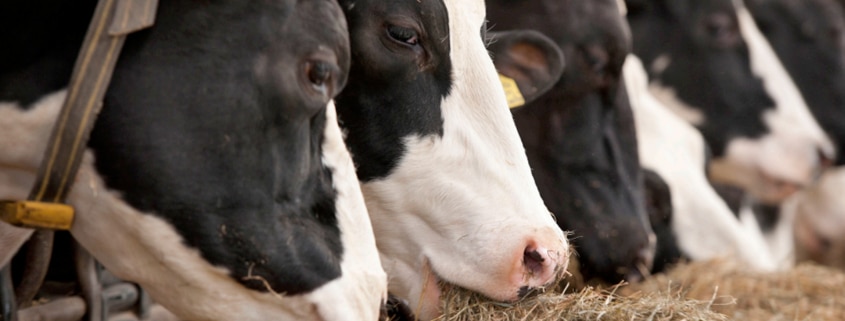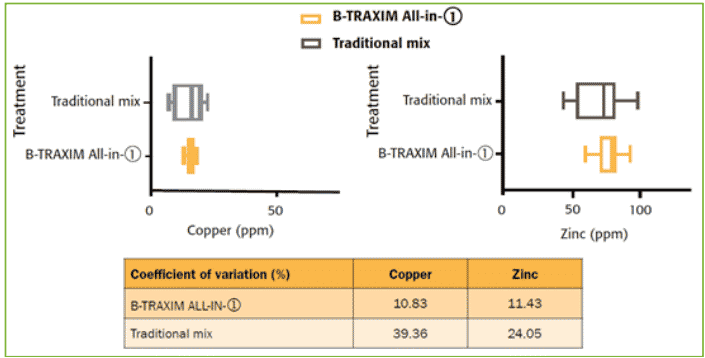Precision feeding in cattle
Precision feeding in cattle boosts production efficiency since every animal is fed according to its individual requirements. Providing the right amount of nutrients ensures optimal performance and reduces the environmental footprint of cattle production by cutting down on waste of nutrients.
BY MIEKE ZOON AND CÉLINE ROBIN, PRODUCT MANAGERS FOR MINERALS
Today’s consumers demand increasingly efficient, low-impact food production, and that includes animal production. This means that in addition to cost efficiency, the sector must also find effective ways to reduce environmental impact. Meanwhile, we have become more aware of the risks of using antibiotics to improve efficiency, due to the development of multi-resistant bacteria. Not to mention animal welfare and quality of life. Each of these challenges may seem very different, even contradictory, but there are solutions which ideally address several issues at once. It’s no surprise that the concept of “precision feeding” is becoming one of the industry’s go-to solutions.
Precision feeding in cattle
Precision feeding in cattle means feeding each and every animal according to its individual requirements. Not only on average but at every feeding, every single day. It boosts efficiency, since the closer feed meets animals’ nutritional requirements, the easier it is for them to reach their full genetic potential. Providing less than the required amount of any important nutrient (e.g. energy, amino acids, vitamins, and trace minerals) will negatively impact performance. Providing the right amount of nutrients is a sustainable way to use resources, ensure optimal performance and reduce the animals’
environmental footprint through less waste of nutrients.
Mineral homogeneity
One of the main challenges in precision feeding is the low level inclusion of essential nutrients such as minerals. In fact, the inclusion level can be so low that it is difficult to ensure homogenous distribution. This can lead to some animals not getting all the nutrients they need.
The latest development and new generation of multi-mineral products is B-Traxim All-in-1. Using Pancosma’s Iso-Fusion technology (IFT), every particle contains exactly the same ratio of each different mineral, resulting in perfectly uniform distribution and homogenous premix and feed. The four different minerals in one B-Traxim All-in-1 product were identified using Scanning Electron Microscopy together with Energy Dispersive X-ray Spectroscopy (SEM-EDX) at the Swiss Centre for Electronics and Microtechnology (CSEM) in Neuchatel, Switzerland. These minerals (Cu, Fe, Mn, Zn) were identified and represented with four different colours.
Figure 1 shows that not only are all four metals present in every particle, but they are very evenly distributed throughout each one. Farmers are looking for a way to provide nutrients homogenously and positively impact animal uniformity, performance and products. A series of tests based on the coefficient of variation confirmed a much lower deviation to the mean with All-in-1 products compared to traditional blends (Figure 1).
Figure 1. Homogeneity in feed – coefficient of variation of copper and zinc contents in B-Traxim All-in-1.
Multi-mineral benefits
Multi-mineral products can also facilitate the day-to-day work of feed mills and on-farm mixers. Having all the necessary minerals in one more concentrated formula reduces the number of silos used and stocks held on site. Plus, administratively, there are fewer orders and registrations to keep track of. B-Traxim PRO4 is an All-in-1 solution containing Zn, Mn, Cu and Co, designed to meet ruminants’ needs. It is based on Pancosma’s glycinate technology that provides higher bioavailability and support to physiological functions compared to inorganic minerals.
Three scientific studies show the added value of B-Traxim PRO4 in ruminant production.” First, a study carried out at North Carolina State University focusing on the bioavailability of minerals in ruminants showed that apparent absorption and retention of Zn and liver zinc concentration were higher for steers supplemented with these organic trace minerals than for animals fed zinc sulphate or another organic source. In another study comparing the organic zinc source to zinc sulphate, North Carolina State University concluded that the organic form had a positive effect on immune parameters. Lastly, a study in Spain investigated vitamin B12 synthesis by micro-organisms in the rumen. Cobalt is a key component of this synthesis and therefore needs to be supplemented and available in the rumen. Compared to an unsupplemented feed, the study showed a significantly greater formation of B12 by the rumen microbial population provided with a feed supplemented with B-Traxim PRO4.
Precision feeding in cattle is a hassle-free approach to consistently providing animals with the nutrients animals need – not more, not less. An effective way to improve performance while reducing waste, it’s good for the animals, good for the environment and good for production.
Related articles
Pancosma organic trace minerals




